Assessment of the Influence of the Selected Range of Visible Light Radiation on the Durability of the Gel with Ascorbic Acid and Its Derivative
Abstract
1. Introduction
2. Results
2.1. Irradiated Substrates
2.1.1. PA Gel with Ascorbic Acid and 3-O-ethyl-L-ascorbic Acid
2.1.2. PA and Glycerol Gel with Ascorbic Acid and 3-O-ethyl-L-asdcorbic Acid
2.1.3. MC Gel with Ascorbic Acid and 3-O-ethyl-L-asdcorbic Acid
2.1.4. AV Gel with Ascorbic Acid and 3-O-ethyl-L-asdcorbic Acid
2.2. Viscosity
2.3. Physicochemical Properties of Ascorbic Acid and 3-O-ethyl-L-ascorbic Acid
2.4. Photostability Mechanism
2.5. FTIR Spectroscopic Studies
2.6. Statistics
F-Test for Linear Correlation and Student’s t-Test
3. Discussion
4. Materials and Methods
4.1. Materials
4.2. Preparation of Gels
4.3. Methods
4.3.1. Spectrophotometric Method
4.3.2. Calibration Curve
4.3.3. The UV Irradiation
4.3.4. Viscosity
4.3.5. Physicochemical Properties of Ascorbic Acid and 3-O-ethyl-L-ascorbic Acid
4.3.6. Density Functional Theory (DFT)
4.3.7. FTIR Spectroscopic Studies
4.3.8. Statistical Analysis
5. Conclusions
Supplementary Materials
Author Contributions
Funding
Institutional Review Board Statement
Informed Consent Statement
Data Availability Statement
Acknowledgments
Conflicts of Interest
References
- Colven, R.M.; Pinnell, S.R. Topical vitamin C in anging. Clin. Dermatol. 1996, 14, 227–234. [Google Scholar] [CrossRef]
- Skov, L.; Hansen, H.; Barker, J.N.W.N.; Simon, J.C.; Baadsgaard, O. Contrasting effects of ultraviolet-A and ultraviolet-B exposure on induction of contact hypersensitivity in human skin. Clin. Exp. Immunol. 1997, 107, 585–588. [Google Scholar] [CrossRef] [PubMed]
- Holzle, E.; Honigsmann, H. UV-radiation-sources, wavelength, environment. J. Dtsch. Dermatol. Ges. 2005, 3, 3–10. [Google Scholar] [CrossRef] [PubMed]
- Hoffman, A.S. Hydrogels for biomedical applications. Adv. Drug Deliv. Rev. 2012, 64, 18–23. [Google Scholar] [CrossRef]
- Wichterle, O.; Lím, D. Hydrophilic Gels for Biological Use. Nat. Cell Biol. 1960, 185, 117–118. [Google Scholar] [CrossRef]
- Caló, E.; Khutoryanskiy, V.V. Biomedical applications of hydrogels: A review of patents and commercial products. Eur. Polym. J. 2015, 65, 252–267. [Google Scholar] [CrossRef]
- Schwarz, T.W.; Levy, G.A. Report on the oxidative degradation of neutralized carbopol. J. Am. Pharm. Assoc. 1958, 47, 442–443. [Google Scholar] [CrossRef]
- Yousif, E.; Haddad, R. Photodegradation and photostabilization of polymers, especially polystyrene: Review. SpringerPlus 2013, 2, 398. [Google Scholar] [CrossRef]
- Deshpande, S.G.; Shirolkar, S. Sustained-release ophthalmic formulations of Pilocarpine. J. Pharm. Pharmacol. 1989, 41, 197–200. [Google Scholar] [CrossRef]
- Adams, I.; Davis, S.; Kershaw, R. Formulation of a Sterile Surgical Lubricant. J. Pharm. Pharmacol. 1972, 24, 178. [Google Scholar]
- Senna, M.; Helal, R.; Mostafa, T.; El-Naggar, A.W.M. Kinetic studies on the thermal decomposition of gamma-irradiated poly(vinyl alcohol (PVA)/methyl cellulose (MC) blends. J. Sci. Res. Sci. 2015, 32, 270–290. [Google Scholar] [CrossRef]
- Baranova, I.; Kovalenko, S.M.; Khokhlenkova, N.V.; Martyniuk, T.V.; Kutsenko, S.A. Prospects of using synthetic and semi- synthetic gelling substances in development of medicinal and cosmetic gels. Asian J. Pharm. 2017, 11, 2–9. [Google Scholar]
- Löffler, M.; Miller, D. Aristoflex AVC: A new pH stable polymer for gels and O/W Emulsions. In Proceedings of the Cosmetic Science Conference 2001—Messe Dosseldorf—Roceedings, Frankfurt, Germany, 24 December 2001; pp. 1–14, XP002991430. [Google Scholar]
- Ravetti, S.; Clemente, C.; Brignone, S.; Hergert, A.L.; Allemandi, D.; Palma, S. Ascorbic acid in skin health. Cosmetics 2019, 6, 58. [Google Scholar] [CrossRef]
- Padh, H. Cellular functions of ascorbic acid. Biochem. Cell Biol. 1990, 68, 1166–1173. [Google Scholar] [CrossRef]
- Lane, D.J.R.; Richardson, D.R. The active role of vitamin C in mammalian iron metabolism: Much more than just enhanced iron absorption! Free Radic. Biol. Med. 2014, 75, 69–83. [Google Scholar] [CrossRef]
- Telang, P.S. Vitamin C in dermatology. Indian Dermatol. Online J. 2013, 4, 143–146. [Google Scholar] [CrossRef]
- Traikovich, S.S. Use of Topical Ascorbic acid and its effects on Photo damaged skin topography. Arch. Otorhinol. Head Neck Surg. 1999, 125, 1091–1098. [Google Scholar]
- Murray, J.; Darr, D.; Reich, J.; Pinnell, S. Topical vitamin C treatment reduces ultraviolet B radiation-induced erythema in human skin. J. Investig. Dermatol. 1991, 96, 587. [Google Scholar]
- Darr, D.; Combs, S.; Dunston, S.; Manning, T.; Pinnell, S.R. Topical vitamin C protects porcine skin from ultraviolet radiation-induced damage. Br. J. Dermatol. 1992, 127, 24753. [Google Scholar] [CrossRef]
- Liao, W.C.; Huang, Y.T.; Lu, L.P.; Huang, W.Y. Antioxidant Ability and Stability Studies of 3-O-Ethyl Ascorbic Acid, a Cosmetic Tyrosinase Inhibitor. J. Cosmet. Sci. 2018, 69, 233–243. [Google Scholar]
- Panicker, C.Y.; Varghese, H.T.; Philip, D. FT-IR, FT-Raman and SERS spectra of vitamin C. Spectroc. Acta Part. A 2006, 65, 802–804. [Google Scholar] [CrossRef] [PubMed]
- Golonka, I.; Oleksy, M.; Junka, A.; Matera-Witkiewicz, A.; Bartoszewicz, M.; Musial, W. Selected physicochemical and biological properties of ethyl ascorbic acid compared to ascorbic acid. Biol. Pharm. Bull. 2017, 40, 1199–1206. [Google Scholar] [CrossRef][Green Version]
- Maia Campos, P.M.B.G.; Gianeti, M.D.; Camargo, F.B., Jr.; Gaspar, L.R. Application of tetra-isopalmitoyl ascorbic acid in cosmetic formulations: Stability studies and in vivo efficacy. Eur. J. Pharm. Biopharm. 2012, 82, 580–586. [Google Scholar] [CrossRef] [PubMed]
- Silverstein, R.M.; Bassler, G.C.; Morrill, T.C. Spectrometric Identification of Organic Compounds; John Wiley & Sons: New York, NY, USA, 1981; pp. 84–106. [Google Scholar]
- Pichara, L.C.; Lanus, C.G.; Nieto, C.G.; Brandan, S.A. Density Functional theory calculations of themolecular force filed of l-ascorbic acid, vitamin C. J. Phys. Chem. 2010, 114, 4997–5004. [Google Scholar]
- Obeidat, S.M.; Hammoudeh, A.Y.; Mahmoud, A. Identification and quantification of diethylene glycol contamination in glycerine raw material, Spectrosc. Letters 2019, 52, 60–65. [Google Scholar]
- Touitou, E.; Gilhar, D.; Alhaique, F.; Memoli, A.; Riccieri, F.M.; Santucci, E. Ascorbic acid in aqueous solution: Bathochromic shift in dilution and degradation. Int. J. Pharm. 1992, 78, 85–87. [Google Scholar] [CrossRef]
- Andrews, G.C.; Crawford, T. Ascorbic Acid: In Chemistry, Metabolism, and Uses; Seib, P.A., Tolbert, B.M., Eds.; American Chemical Society: Washington, DC, USA, 1982; pp. 59–79. [Google Scholar]
- Lavrenov, S.N.; Preobrazhenskaya, M.N. L-Ascorbic Acid: Properties and Ways of Modification (A Review). Pharm Chem. J. 2005, 39, 251–264. [Google Scholar] [CrossRef]
- Iliopoulos, F.; Sil, B.C.; Moore, D.J.; Lucas, R.A.; Lane, M.E. 3-O-ethyl-l-ascorbic acid: Characterisation and investigation of single solvent systems for delivery to the skin. Int. J. Pharm. X 2019, 1, 100025. [Google Scholar] [CrossRef]
- Chuy, S.; Bell, L.N. Buffer pH and pKa values as affected by added glycerol and sucrose. Food Res. Int. 2006, 39, 342–348. [Google Scholar] [CrossRef]
- Golonka, I.; Wilk, S.; Musiał, W. The influence of UV radiation on the degradation of pharmaceutical formulations containing quercetin. Molecules 2020, 25, 5454. [Google Scholar] [CrossRef]
- Bandelin, F.J.; Tuschhoff, J.V. The stability of ascorbic acid in various liquid madia. J. Am. Pharm. Assoc. 1995, 44, 241–244. [Google Scholar]
- Puzenko, A.; Hayashi, Y.; Ryabov, Y.E.; Balin, I.; Feldman, Y.; Kaatze, U.; Behrends, R. Relaxation dynamics in glycerol-water mixtures: I. glycerol-rich mixtures. J. Phys. Chem. B 2005, 109, 6031–6035. [Google Scholar] [CrossRef]
- Hayashi, Y.; Puzenko, A.; Balin, I.; Ryabov, E.; Feldman, Y. Relaxation dynamics in glycerol–water mixtures. 2. mesoscopic feature in water rich mixtures. J. Phys. Chem. B 2005, 109, 9174–9177. [Google Scholar] [CrossRef] [PubMed]
- Towey, J.J.; Dougan, L. Structural examination of the impact of glycerol on water structure. J. Phys. Chem. B 2012, 116, 1633–1641. [Google Scholar] [CrossRef] [PubMed]
- Nakagawa, H.; Oyama, T. Molecular basic of water activity in glycerol-water mixtures. Front. Chem. 2019, 731, 1–9. [Google Scholar]
- Sungthongjeen, S. Application of Arrhenius Equation and Plackett-Burman Design to Ascorbic Acid Syrup Development. J. Naresuan Univ. 2004, 12, 1–12. [Google Scholar]
- Okumura, M.; Ohta, T. Suspension of Ascorbic Acid in Glycerin and Proces for Production Thereof. Patent No. US8,211, 472 B2, 3 July 2012. [Google Scholar]
- Rostami, A.M.; Kiani, F.; Ghorbani-Hasan, S.A.; Koohyar, F.; Omran, M.M. Measurement of thermophysical properties of binary system of (water + ascorbic acid) and ternary systems of (water + ascorbic acid + glycerol) and (water + ascorbic acid + D-sorbitol) at T = 293.15 K to 323.15 K and atmospheric pressure. J. Mol. Liq. 2019, 281, 471–479. [Google Scholar] [CrossRef]
- Kuellmer, V. Kirk Othmer Encyclopedia of Chemical Technology; John Wiley & Sons: New York, NY, USA, 16 April 2001. [Google Scholar]
- Jerzykiewicz, M.; Cwielag, I.; Jerzykiewicz, W. The antioxidant and anticorrosive properties of crude glicerol fraction from biodiesel production. J. Chem. Technol. Biol. 2009, 84, 1196–1201. [Google Scholar]
- Koohyar, F.; Rostami, A.A.; Chaichi, M.J.; Kiani, F. Refractive indices, viscosities, and densities for L-cysteine hydrochloride monohydrate + D-sorbitol + water, and glycerol + D-sorbitol + water in the temperature range between T = 303.15 K and T = 323.15 K. J. Solut. Chem. 2011, 40, 1361–1370. [Google Scholar] [CrossRef]
- Perdew, J.P.; Burke, K.; Ernzerhof, M. Generalized Gradient Approximation Made Simple. Phys. Rev. Lett. 1996, 77, 3865. [Google Scholar] [CrossRef]
- Zhang, H.; Grinstaff, M.W. Recent Advances in Glycerol Polymers: Chemistry and Biomedical Applications. Macromol. Rapid Commun. 2014, 35, 1906–1924. [Google Scholar] [CrossRef] [PubMed]
- Habuka, A.; Yamada, T.; Nakashima, S. Interactions of Glycerol, Diglycerol, and Water Studied Using Attenuated Total Reflection Infrared Spectroscopy. J. Appl. Spectrosc. 2020, 74, 767–779. [Google Scholar] [CrossRef] [PubMed]
- Frisch, M.J.; Trucks, G.W.; Schlegel, H.B.; Scuseria, G.E.; Robb, M.A.; Cheeseman, J.R.; Scalmani, G.; Barone, V.; Pe-tersson, G.A.; Nakatsuji, H.; et al. Gaussian 16, Revision C.01; Gaussian, Inc.: Wallingford, CT, USA, 2016.
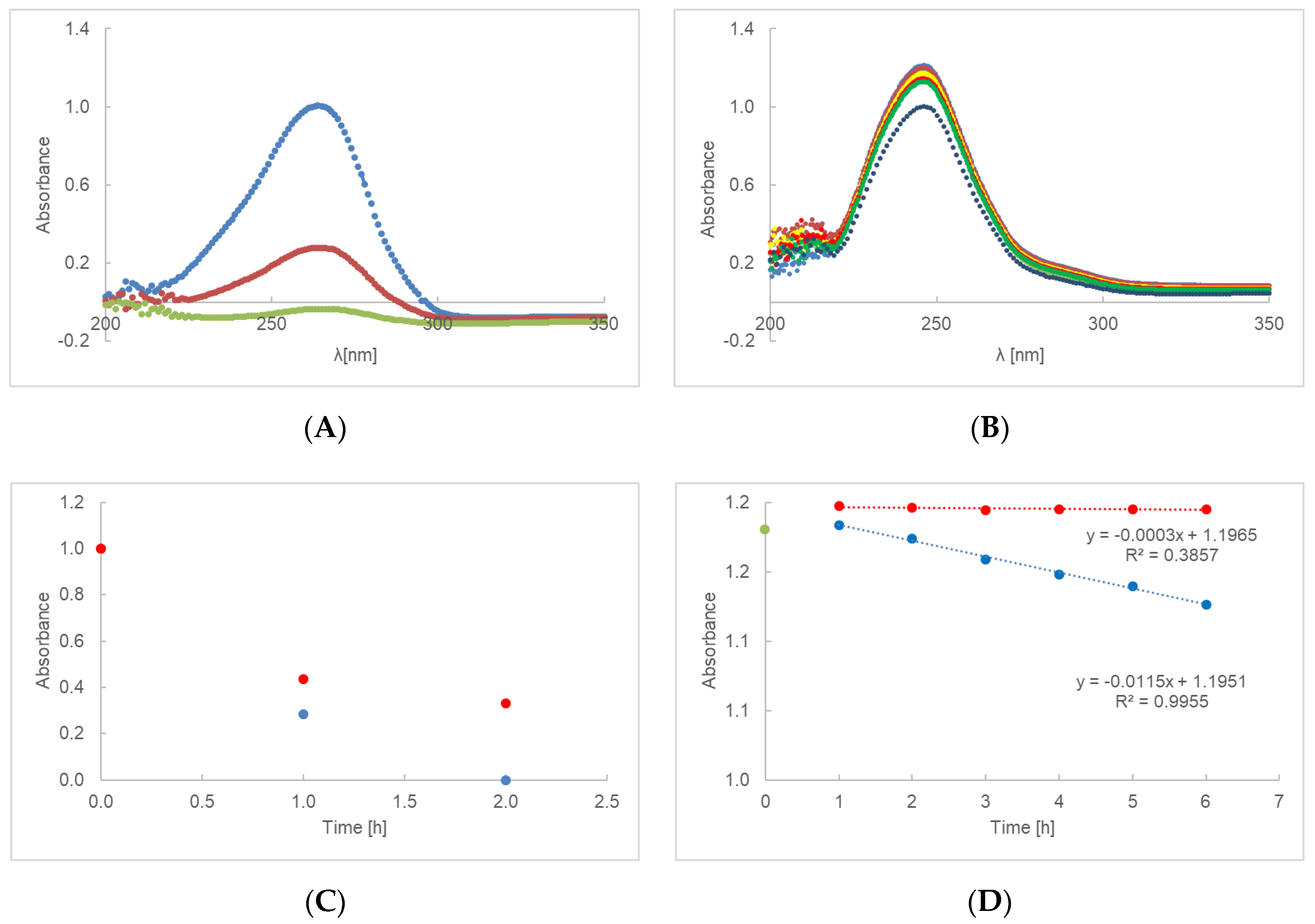
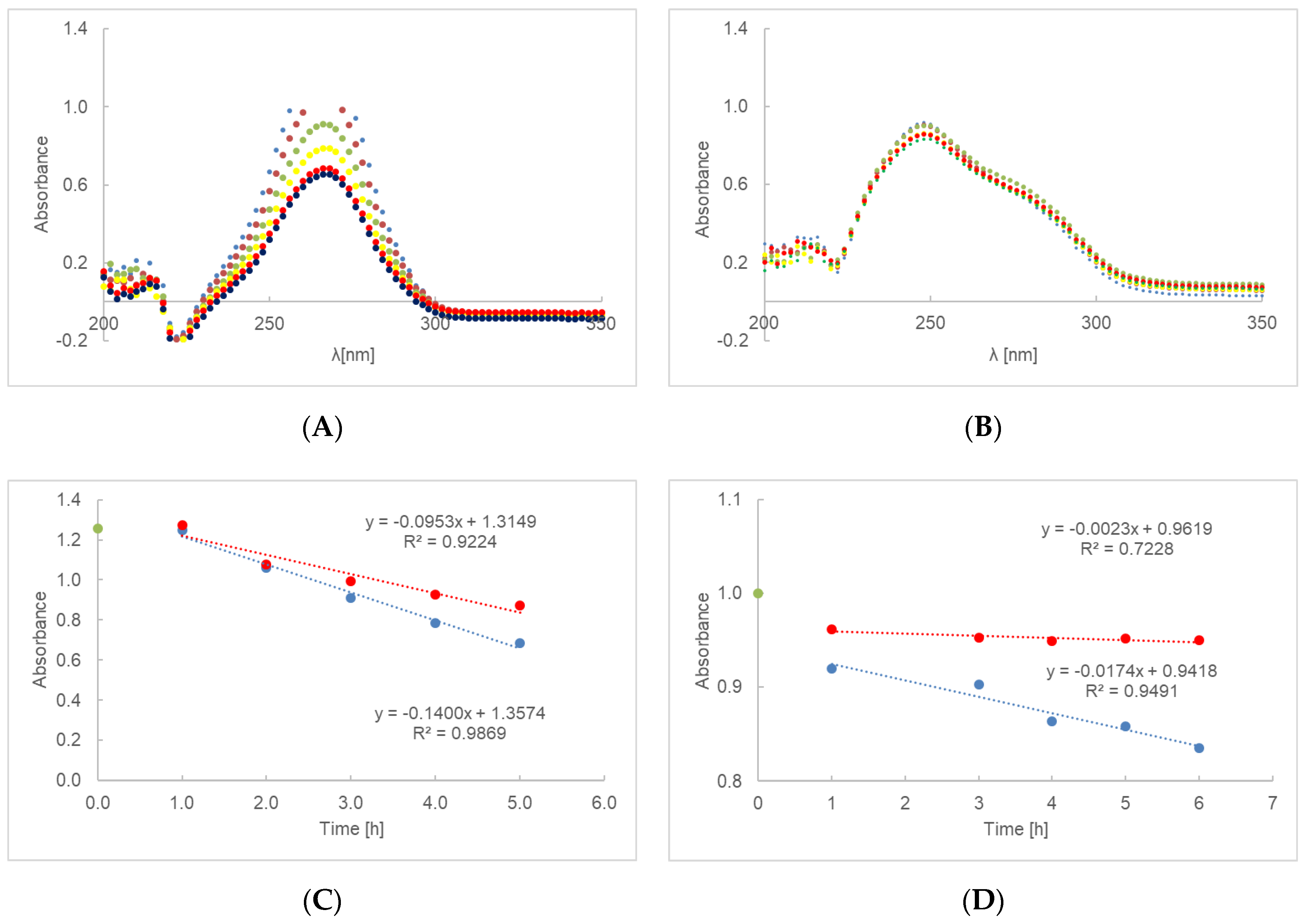
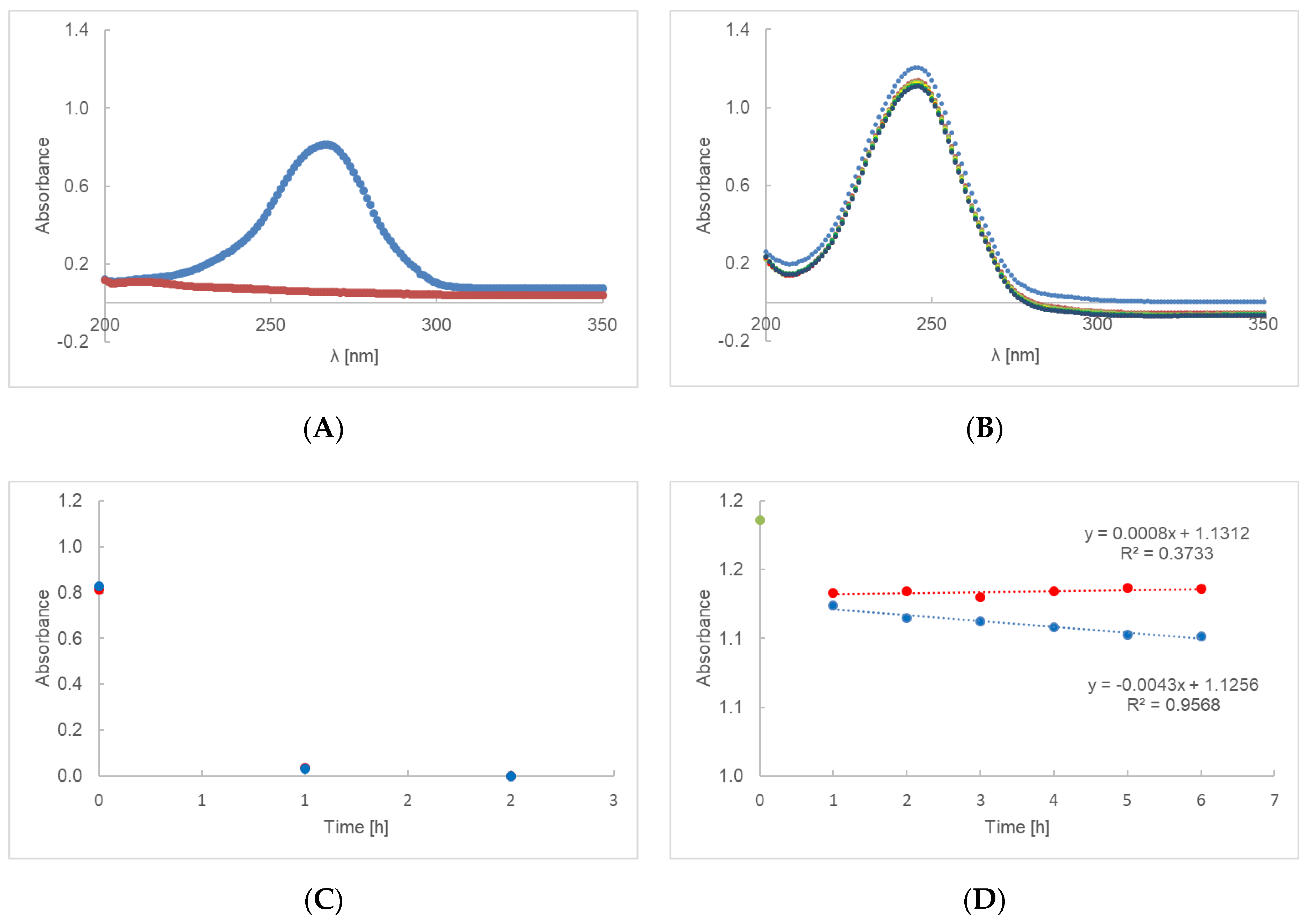
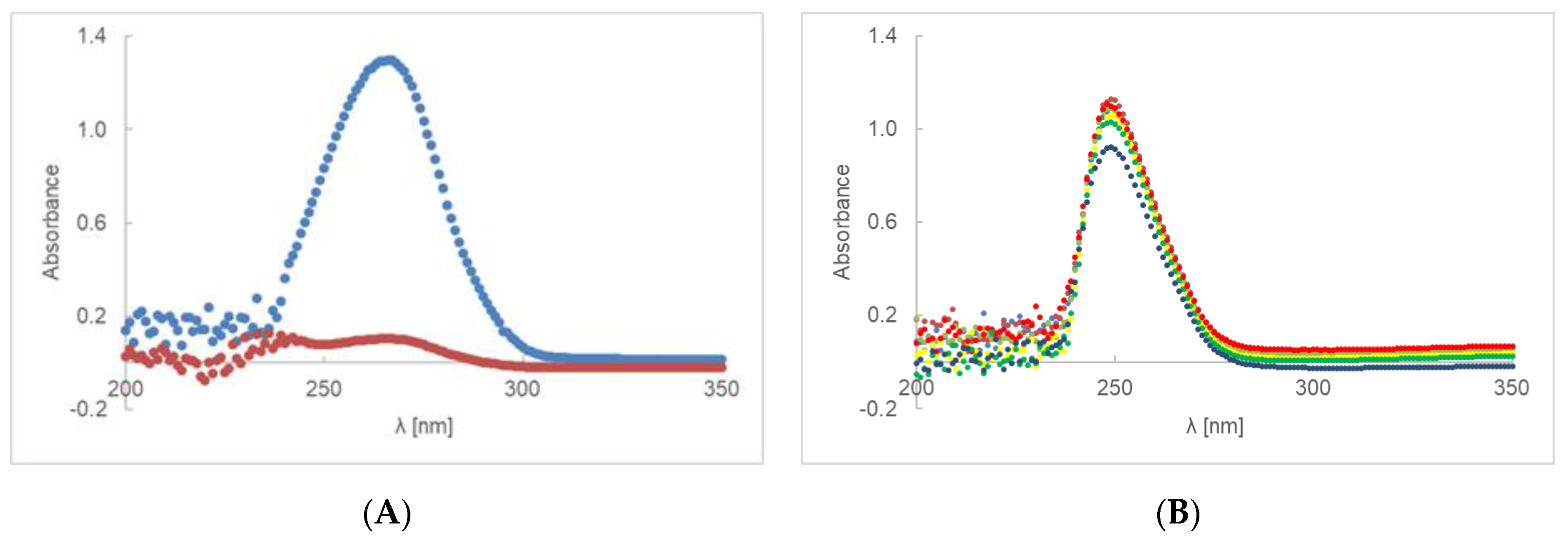
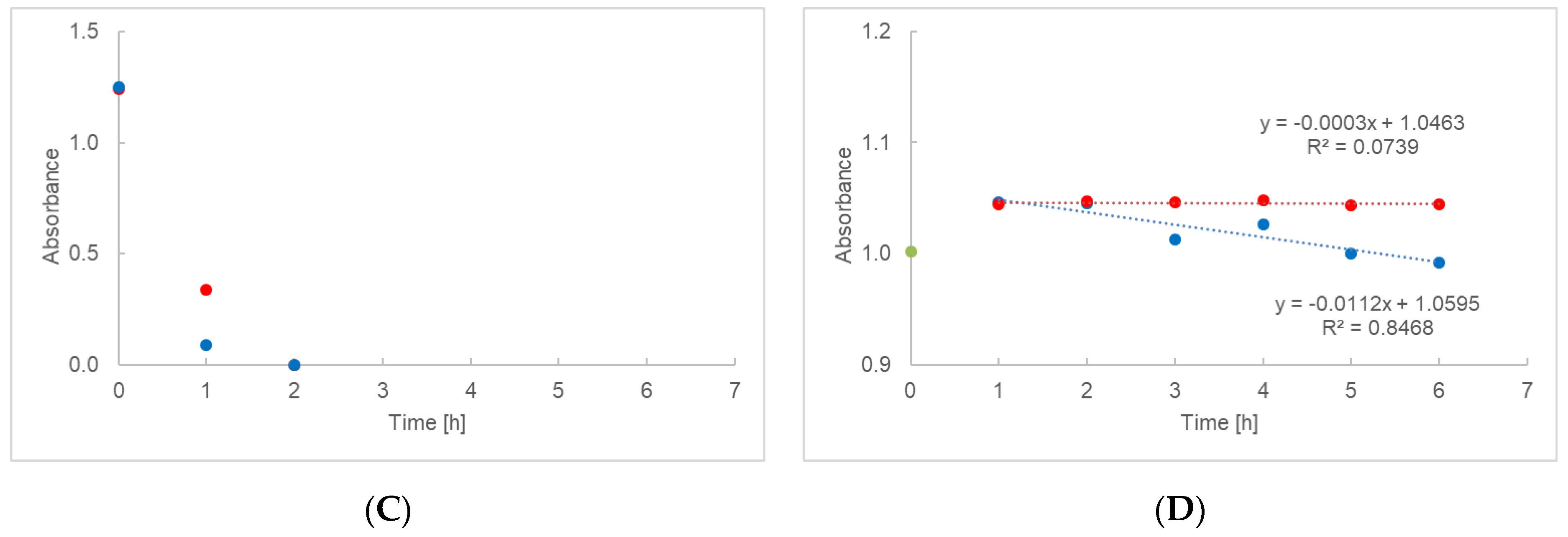
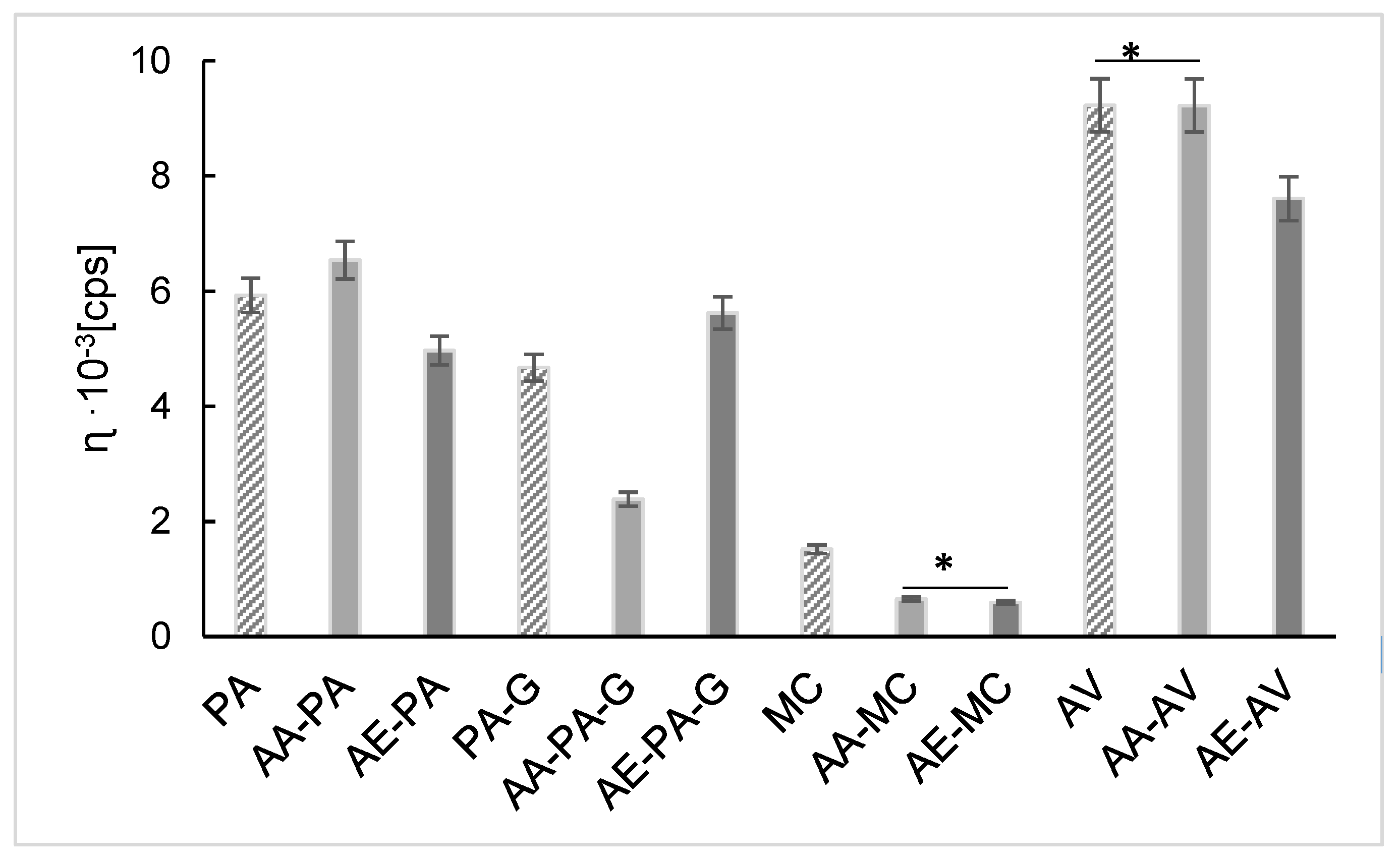
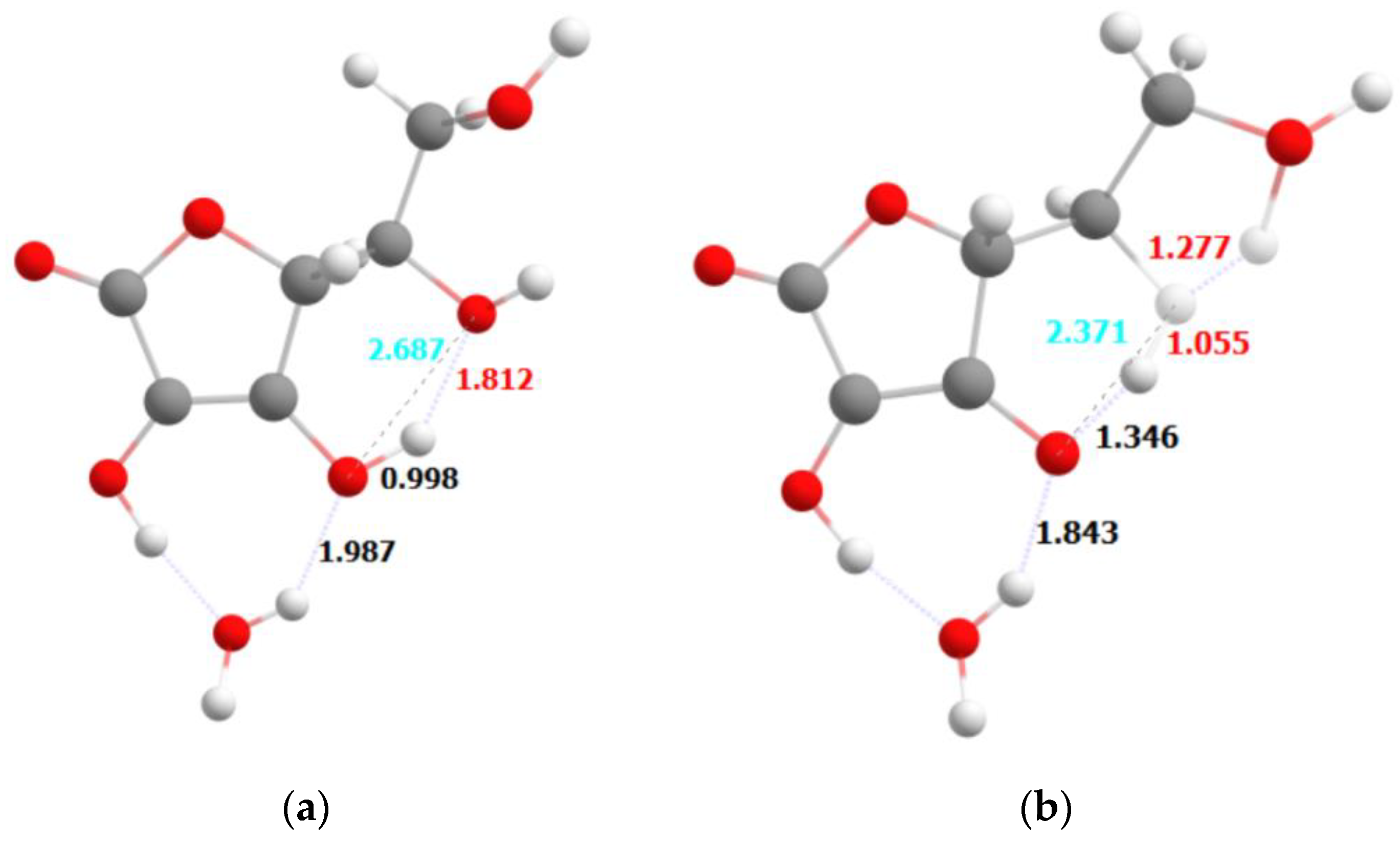
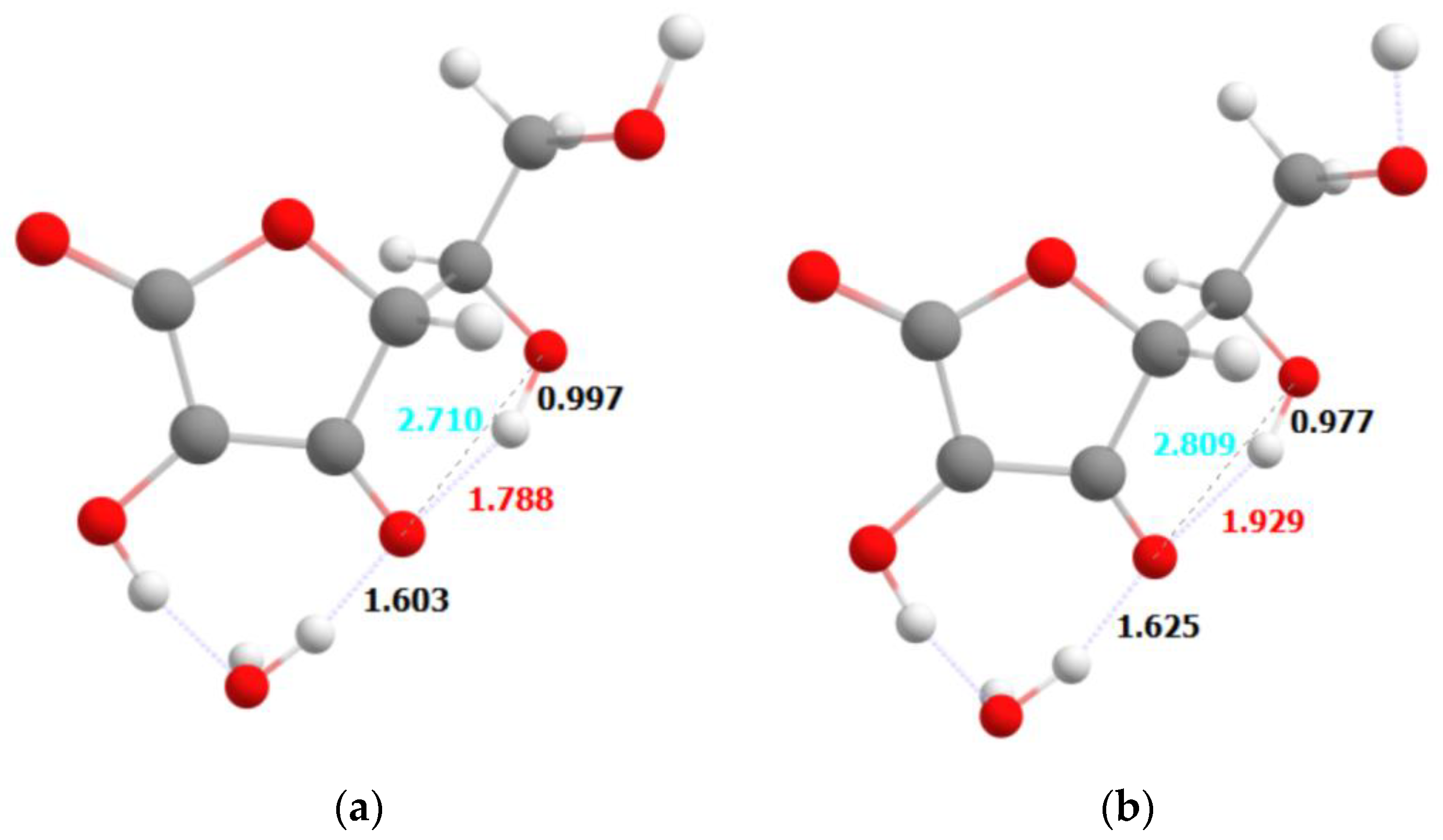


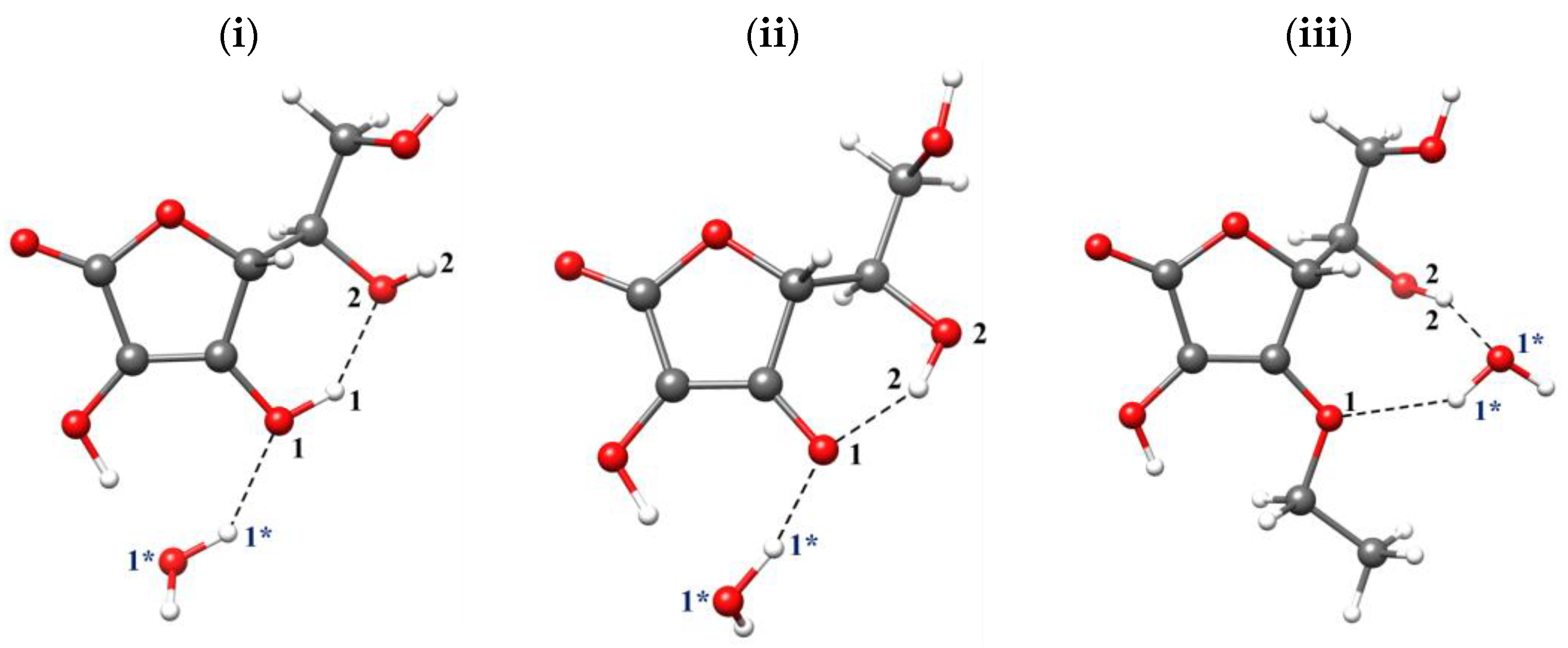
| AA-PA | AE-PA | PA-G | AA-PA-G | AE-PA-G | MC | AA-MC | AE-MC | AV | AA-AV | AE-AV | |
| PA | 0.6113 | 0.961 | 1.257 | 3.543 | 0.309 | 4.410 | 5.276 | 5.337 | 3.300 | 3.294 | 1.678 |
| AA-PA | 1.573 | 1.869 | 4.154 | 0.920 | 5.021 | 5.888 | 5.948 | 2.689 | 2.683 | 1.067 | |
| AE-PA | 0.296 | 2.582 | 0.653 | 3.449 | 4.315 | 4.376 | 4.261 | 4.255 | 2.639 | ||
| PA-G | 2.286 | 0.949 | 3.153 | 4.019 | 4.080 | 4.557 | 4.551 | 2.935 | |||
| AA-PA-G | 3.234 | 0.867 | 1.734 | 1.794 | 6.843 | 6.837 | 5.221 | ||||
| AE-PA-G | 4.968 | 4.968 | 5.028 | 3.609 | 3.603 | 1.987 | |||||
| MC | 0.866 | 0.927 | 7.710 | 7.704 | 6.088 | ||||||
| AA-MC | 0.061 | 8.576 | 8.570 | 6.954 | |||||||
| AE-MC | 8.637 | 8.631 | 7.015 | ||||||||
| AV | 0.006 | 1.622 | |||||||||
| AA-AV | 1.616 |
| Naming | Ascorbic Acid | 3-O-ethyl-L-ascorbic Acid |
|---|---|---|
| Molecular Formula | C6H8O6 | C8H12O6 |
| Molar Refractivity | 35.26 ± 0.3 cm3 | 44.65 ± 0.4 cm3 |
| Molar Volume | 90.1 ± 3.0 cm3 | 139.0 ± 5.0 cm3 |
| Polarizability | 13.97 ± 0.5 10−24 cm3 | 17.70 ± 0.5 10−24 cm3 |
| RDBE (Ring Double Bond Equivalents) | 3 | 3 |
| Average Mass | 176.1241 Da | 204.1773 Da |
| logP | −2.41 ± 0.45 | −1.81 ± 0.52 |
| Preparation | Bands Alteration Regions Observed Unexposed [cm−1] | Bands Alteration Regions Observed after Irradiation [cm−1] |
|---|---|---|
| AA-PA | no differences | no differences |
| AA-PA-G | 3278, 2935,2879, 1653,1564, 569, 480 | 3274, 2934, 2880, 2066, 1652, 1561, 560 |
| AA-MC | 1652, 1316, 1273, 1023 | 1656, 1318, 1274, 1024, 497, 485 |
| AA-AV | 3524, 3309, 3205, 3032, 2916, 1754, 1648, 1313, 1274, 1179, 1138, 1024, 870, 473, 447 | 3523, 3307, 3203, 3057, 1755, 1644, 1299, 1178, 1151, 1036, 445 |
| AE-PA | 3305, 1673, 526 | 3313, 1671, 780, 541 |
| AE-PA-G | 3278, 2936, 2879, 2144, 1652, 1561, 1406, 1323, 1209, 1108, 1035, 994, 923, 851, 569, 487 | 3277, 2935, 2880, 1980, 1654, 1565, 1408, 1325, 1208, 1110, 1040, 995, 924, 852, 560 |
| AE-MC | 3413, 3305, 1744, 1685, 1403, 1378, 1330, 1200, 1051, 945, 885, 821, 761, 460 | 3466, 3418, 2917, 2850, 2466, 1660, 1440, 1338, 1236, 1061, 552, 467 |
| AE-AV | 3231, 2886, 2112, 1754, 1655, 1548, 1443, 1420, 1378, 1150, 1113, 1036, 937, 869, 761, 722, 507 | 3208, 3070, 2931, 2100, 1743, 1676, 1647, 1549, 1442, 1380, 1321, 1293, 1151, 1116, 1082, 1035, 938, 872, 757, 732, 523, 479 |
| Parameter | AE-PA | AA-PA-G | AE-PA-G | AE-MC | AE-AV | |||||
|---|---|---|---|---|---|---|---|---|---|---|
| Irradiated | Unexposed | Irradiated | Unexposed | Irradiated | Unexposed | Irradiated | Unexposed | Irradiated | Unexposed | |
| slope factor a | −0.0115 | −0.0003 | −0.1400 | −0.0953 | −0.0174 | −0.0023 | 0.0043 | 0.0008 | −0.0112 | 0.0003 |
| coefficient b | 1.1951 | 1.1965 | 1.3574 | 1.3149 | 0.9418 | 0.9619 | 1.1256 | 1.1312 | 1.0595 | 1.0463 |
| standard error a | 0.0004 | 0.0002 | 0.0093 | 0.0160 | 0.0020 | 0.0008 | 0.0005 | 0.0005 | 0.0024 | 0.0031 |
| standard error b | 0.0015 | 0.0008 | 0.0309 | 0.0529 | 0.0078 | 0.0034 | 0.0018 | 0.0020 | 0.0093 | 0.0120 |
| linear correlation coefficient | 0.9955 | 0.3857 | 0.9869 | 0.9224 | 0.9491 | 0.7228 | 0.9568 | 0.3733 | 0.8468 | 0.0653 |
| standard error of y stimation | 0.0016 | 0.0009 | 0.0294 | 0.0505 | 0.0084 | 0.0031 | 0.0019 | 0.0022 | 0.0100 | 0.0129 |
| Parameters of F-test | |||||
| Parameter | AE-PA | AA-PA-G | AE-PA-G | AE-MC | AE-AV |
| F | 2.3830 | 47.543 | 64.405 | 0.3191 | 0.3192 |
| p | p > 0.05 | p > 0.05 | p > 0.05 | p > 0.05 | p > 0.05 |
| Parameters of Student’s t-test | |||||
| Parameter | AE-PA | AA-PA-G | AE-PA-G | AE-MC | AE-AV |
| t | 25.1859 | 0.2210 | 5.7483 | 7.3800 | 0.6131 |
| p | 0.0039 | 0.0039 | 0.0039 | 0.0039 | 0.0039 |
| Samples Group | Sample Acronym | PA [g] | MC [g] | AV [g] | NaOH [g] | G-Glycerol [g] | Aqua [g] | AA [g] | AE [g] |
|---|---|---|---|---|---|---|---|---|---|
| Basic gels | PA | 0.3 | - | - | q.s. * | - | 94.7 | - | - |
| PA-G | 0.3 | - | - | q.s. * | 25 | 74.7 | - | - | |
| MC | - | 2 | - | - | - | 98.0 | - | - | |
| AV | - | - | 2 | - | - | 98.0 | - | - | |
| Gels with AA | AA-PA | 0.3 | - | - | q.s. * | - | 94.7 | 0.035 | - |
| AA-PA-G | 0.3 | - | - | q.s. * | 25 | 74.7 | 0.035 | - | |
| AA-MC | - | 2 | - | - | - | 98.0 | 0.035 | - | |
| AA-AV | - | - | 2 | - | - | 98.0 | 0.035 | - | |
| Gels with AE | AE-PA | 0.3 | - | - | q.s. * | - | 94.7 | - | 0.013 |
| AE-PA-G | 0.3 | - | - | q.s. * | 25 | 74.7 | - | 0.013 | |
| AE-MC | - | 2 | - | - | - | 98.0 | - | 0.013 | |
| AE-AV | - | - | 2 | - | - | 98.0 | - | 0.013 |
| Preparation | AA-PA | AA-PA-G | AA-MC | AA-AV | AE-PA | AE-PA-G | AE-MC | AE-AV |
|---|---|---|---|---|---|---|---|---|
| slope factor a | 802.86 | 769.66 | 721.43 | 868.60 | 2008.4 | 402.909 | 2241.19 | 2036.7 |
| standard error for a | 37.53 | 50.12 | 59.80 | 49.64 | 80.47 | 65.786 | 81.500 | 112.45 |
| coefficient b | −0.093 | 0.069 | 0.016 | −0.017 | 0.054 | −0.189 | 0.093 | 0.018 |
| standard error for b | 0.033 | 0.078 | 0.053 | 0.046 | 0.021 | 0.209 | 0.023 | 0.031 |
| linear correlation coefficient | 0.989 | 0.992 | 0.967 | 0.987 | 0.994 | 0.949 | 0.996 | 0.991 |
Publisher’s Note: MDPI stays neutral with regard to jurisdictional claims in published maps and institutional affiliations. |
© 2022 by the authors. Licensee MDPI, Basel, Switzerland. This article is an open access article distributed under the terms and conditions of the Creative Commons Attribution (CC BY) license (https://creativecommons.org/licenses/by/4.0/).
Share and Cite
Golonka, I.; Kizior, B.; Szyja, B.M.; Damek, M.P.; Musiał, W. Assessment of the Influence of the Selected Range of Visible Light Radiation on the Durability of the Gel with Ascorbic Acid and Its Derivative. Int. J. Mol. Sci. 2022, 23, 8759. https://doi.org/10.3390/ijms23158759
Golonka I, Kizior B, Szyja BM, Damek MP, Musiał W. Assessment of the Influence of the Selected Range of Visible Light Radiation on the Durability of the Gel with Ascorbic Acid and Its Derivative. International Journal of Molecular Sciences. 2022; 23(15):8759. https://doi.org/10.3390/ijms23158759
Chicago/Turabian StyleGolonka, Iwona, Beata Kizior, Bartłomiej M. Szyja, Mateusz P. Damek, and Witold Musiał. 2022. "Assessment of the Influence of the Selected Range of Visible Light Radiation on the Durability of the Gel with Ascorbic Acid and Its Derivative" International Journal of Molecular Sciences 23, no. 15: 8759. https://doi.org/10.3390/ijms23158759
APA StyleGolonka, I., Kizior, B., Szyja, B. M., Damek, M. P., & Musiał, W. (2022). Assessment of the Influence of the Selected Range of Visible Light Radiation on the Durability of the Gel with Ascorbic Acid and Its Derivative. International Journal of Molecular Sciences, 23(15), 8759. https://doi.org/10.3390/ijms23158759








